Norman Knight 1066 CE
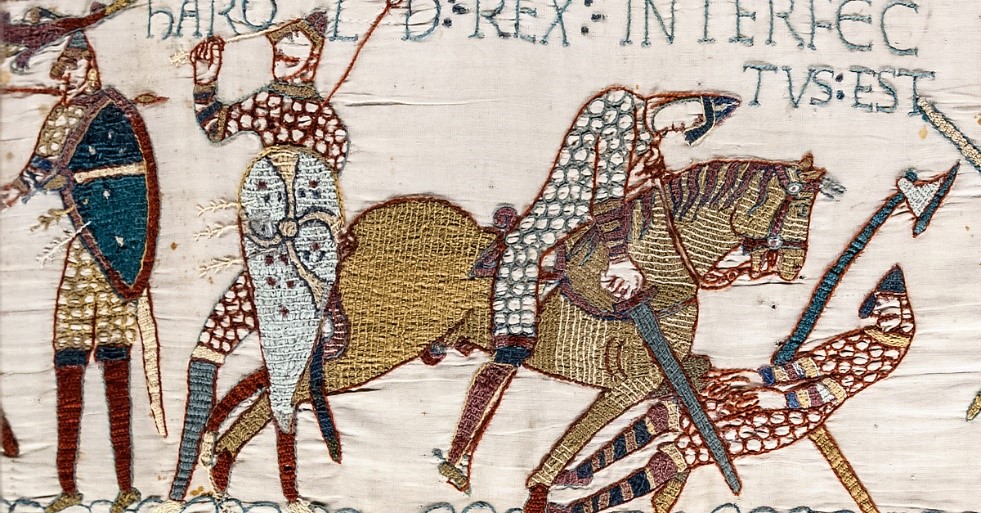
The events of the invasion of Britton by the forces of William of Normandy are famously depicted in the Bayeux Tapestry. On this famous piece of historic art we can see many examples of the kind of armor used as the forces from Normandy attacked the forces of Harold Godwinson. The resulting shift of power from the Anglo-Saxons the Normans had long lasting consequences which is why we chose this iconic warrior’s equipment as a display.
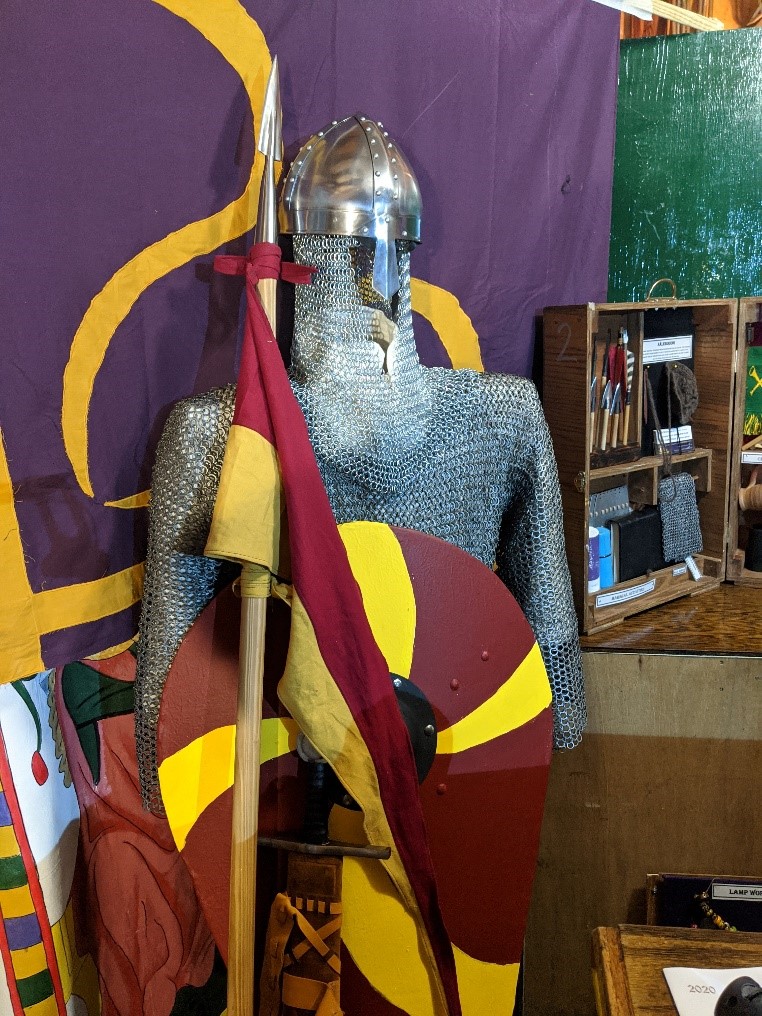
Conical Helm
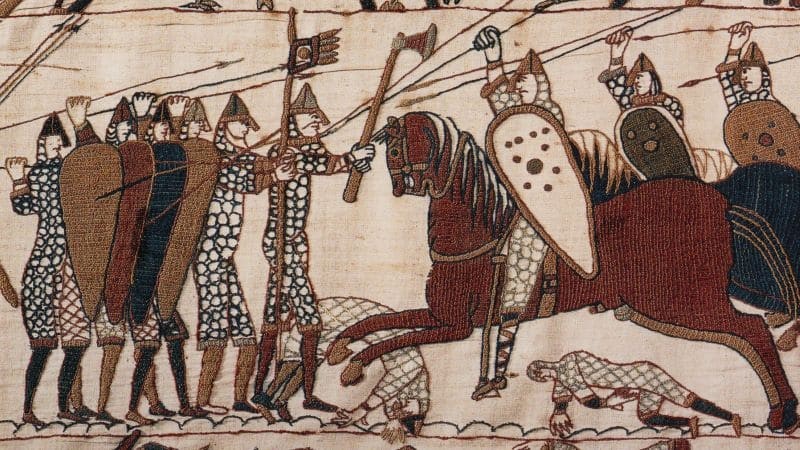
Depicted many times in the tapestry we see many of the Normans and Anglo Saxons wearing these helms. Often constructed from smaller plates of metal riveted together and featuring a nose guard, they did not cover the back of the neck or cheeks. Helms would soon see much development in following years, evolving to cover and protect more of the face and neck.
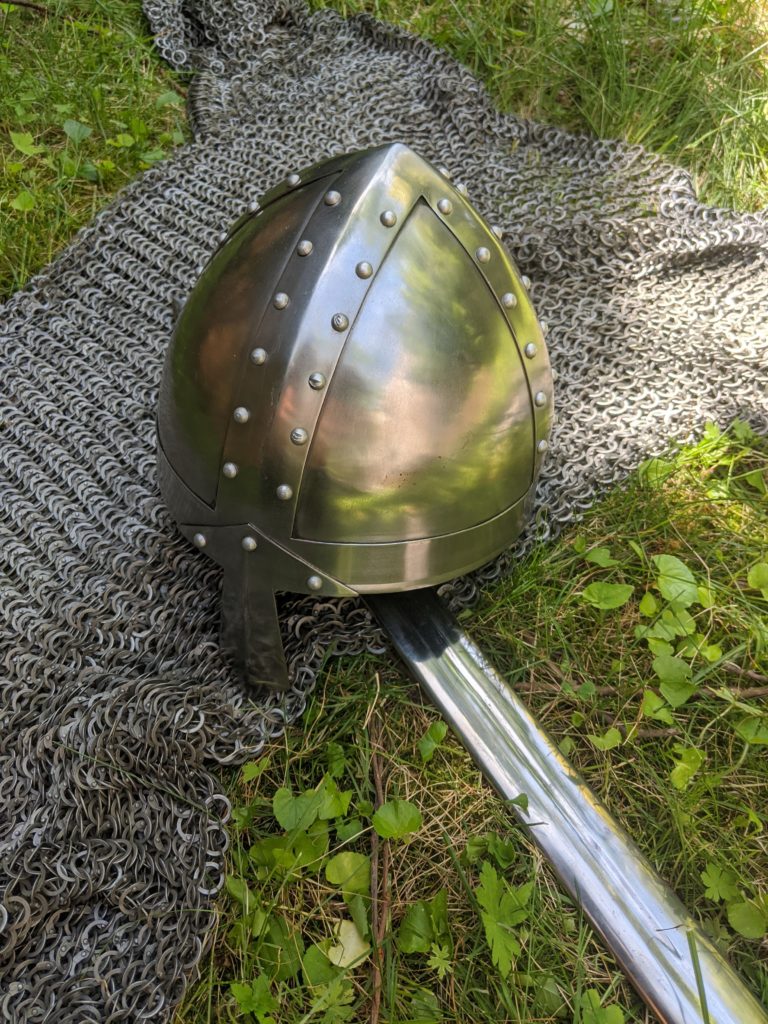
This helm has the four smaller metal plates dished to shape and then riveted to the supporting cross bars. A leather fixture inside the helm helps it to fit to the head and cushion impacts. The form of this liner is speculated as no surviving helmet liners from this time period exist, although many helmets do. The liner may also have had a padded cloth component and ties instead of a buckle. The helm would likely have been painted to match the wearer’s heraldic colors and to protect it from rusting.
Riveted Mail
Often called by the modern name of ‘chain mail,’ mail (or maille) armor had been in use for hundreds of years before the battle in 1066, and even has uses to this day. These shirts of mail were constricted by specialized craftsmen and represented a tremendous cost. Wire was drawn through draw plates until it reached the correct thickness, was coiled around a metal rod and then cut into individual rings. From there the ends were flattened and punctured with a punch allowing them to be riveted together to form solid rings.
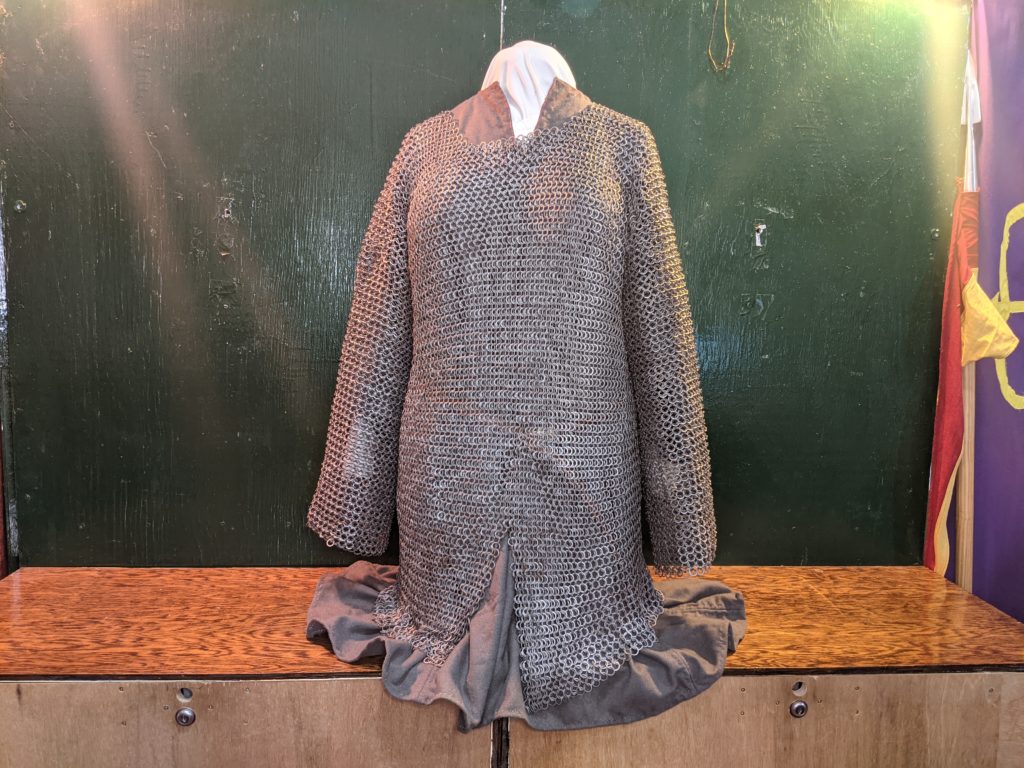
This mail shirt has alternating rows of riveted and solid rings and is woven in the normal European 4 in 1 pattern, where each ring passes through 4 other rings.
The mail coif, or head covering, of our Knight is an example of butted mail. In this the rings are not fastened and can be bent open more easily. Mail like this would likely not be used historically as it did not provide as much protection as the riveted mail. Many beginner armorers in the SCA enjoy exploring making their own butted mail as it is inexpensive and very easy to try.
Wool Tunic
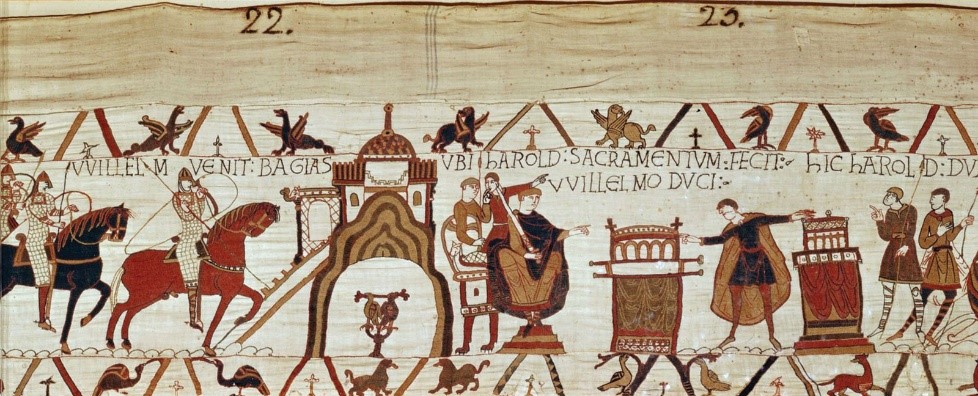
Our Norman Knight display is shown with a long wool over tunic as well as a shorter under tunic. This type of garment can be seen on many of the people in the Bayeux Tapestry who are not depicted in armor. A long tunic would have been the garment worn by men of all stations and positions, from kings to commoners. The tunics of the kings may be been made from finer cloth, from soft and more finely spun wool or silks imported from the East. Many of the finer garments would be decorated with an applique of fine fabrics or with embroidery.
Wool was not only one of the main fabrics for constructing garments across Europe, it was one of the reasons Britton was such a big prize to the Normans. The wool produced in Britton was among the highest quality in Europe. The production and sale of raw wool and to a lesser extent finished cloth brought much money into Britton, making it a wealthy prize for the invaders.
The Red Wool Tunic –
This wool tunic is hand finished from modern, commercially made wool fabric with some linen edging. It is hand finished and its color, although from a modern dye, matches closely with colors produced historically by madder, iron and woad dye baths or by a walnut husk dye process. This style of tunic is based on the Birka dig tunic and represents a common starting point for many reenactors who participate in the SCA.
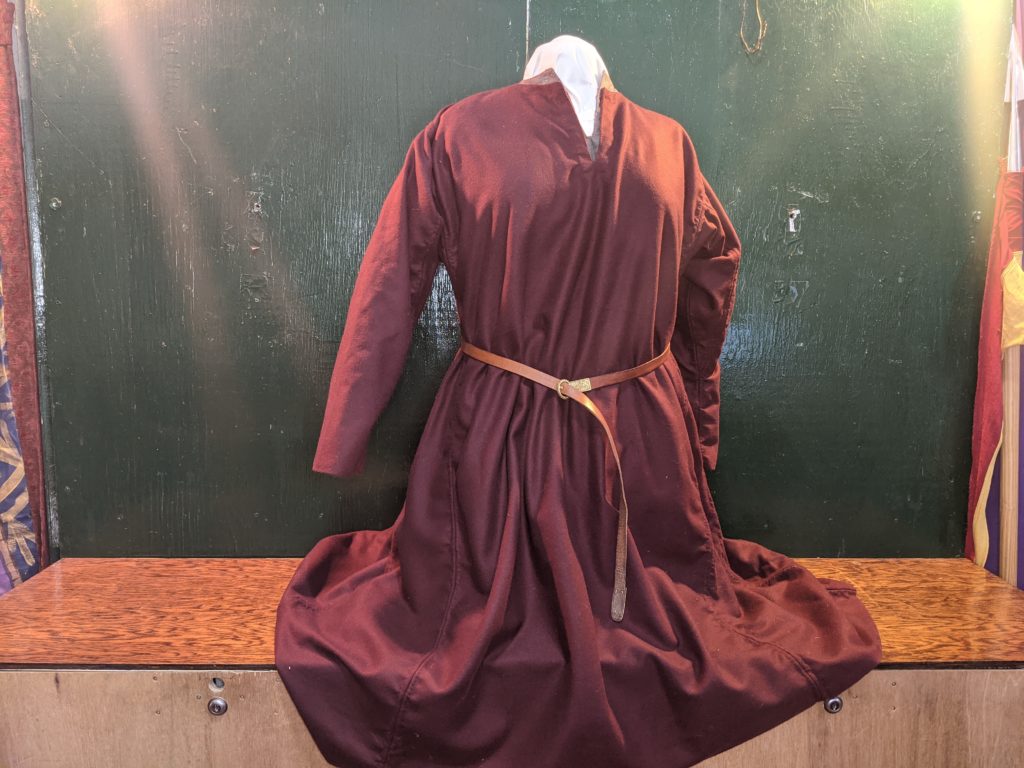
The Gray Wool Tunic –
This wool tunic is hand finished from modern, commercially made wool fabric with some linen edging. It is hand finished and its color, although from a modern dye, matches closely a color possible with a historically available light woad dye. This style of tunic is based on the Birka dig tunic and represents a common starting point for many reenactors who participate in the SCA.
Hosen and Cross Garters
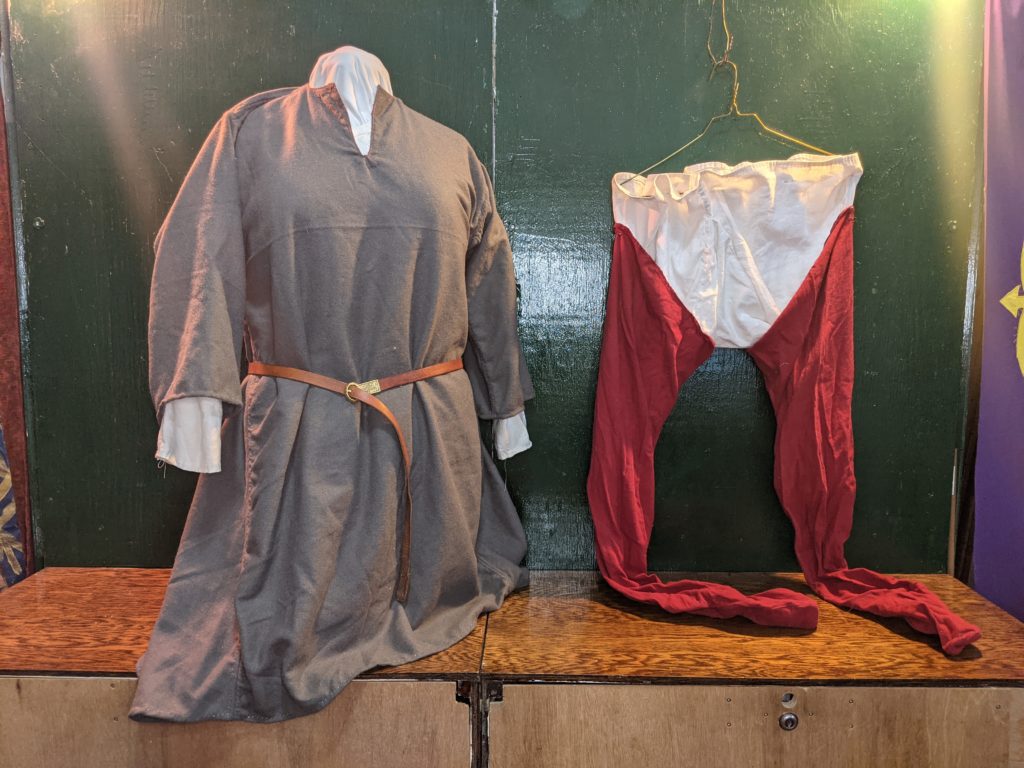
In this time period leg coverings could be pant like trues or split hose. For our display you can see a set of split hose to cover our Norman Knight’s legs. These would be tied to the girdle, an under belt, or to the other undergarment, the braies. Both trues and hosen would be made to fit tighter to the legs with leg wraps or with garter wraps, commonly called cross gartering. These strips likely made from woven bands or leather strips, would be wrapped back and forth or around the leg, holding the fabric close to the legs and keeping them in place.
Wool Cloak
Some of the people in the Bayeux Tapestry can be seen wearing simple cloaks pinned at the right shoulder. These cloaks are commonly rectangular or semicircular wool fabric pieces held in place with pins. They could be plain or richly decorated.
Sword, Sheath and Sword Belt
Swords are symbols of power and tools for the forces of the powerful. We see many swords depicted in the Bayeux Tapestry, including the one used by this Norman horseman cutting down the Anglo-Saxon axeman.
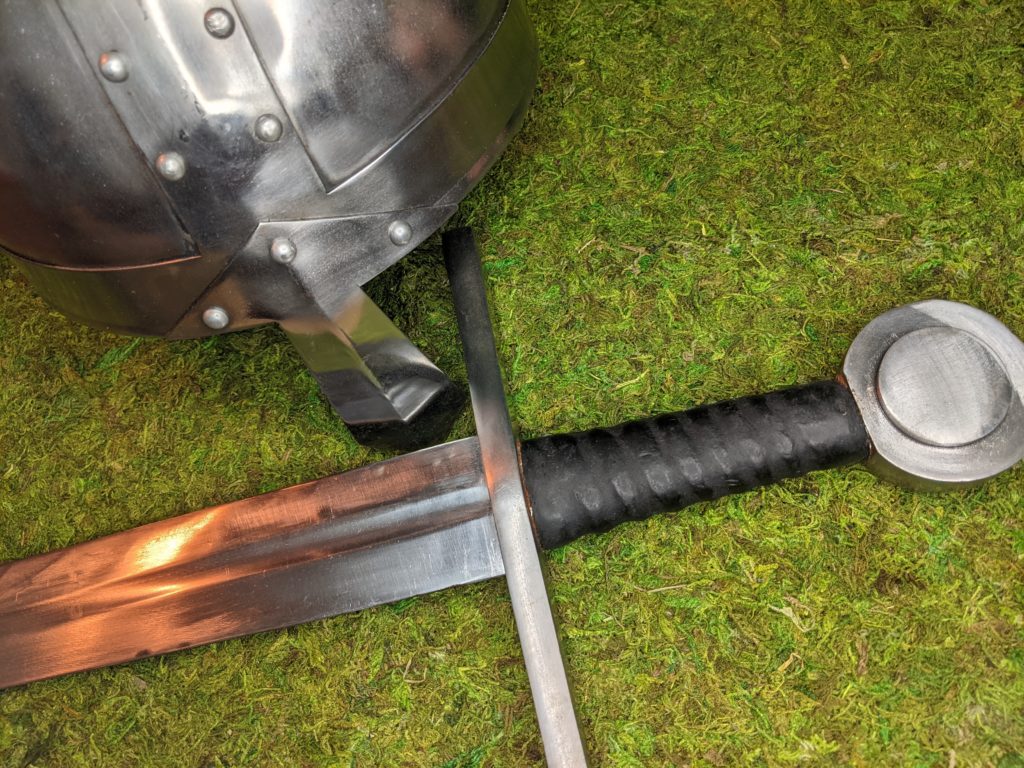
The sword of our Norman Knight is a modern reproduction but it closely matches a sword that would have been used by some during this time period (Type Xa Cross style 1).
The sheath is a maple wood core. The two boards of the core are carved out to match the profile of the blade exactly before being glued together. The outside was then shaved down to decrease the size and weight of the sheath. The leather is tooled with a simple design and glued to the core as well as being stitched along the back.
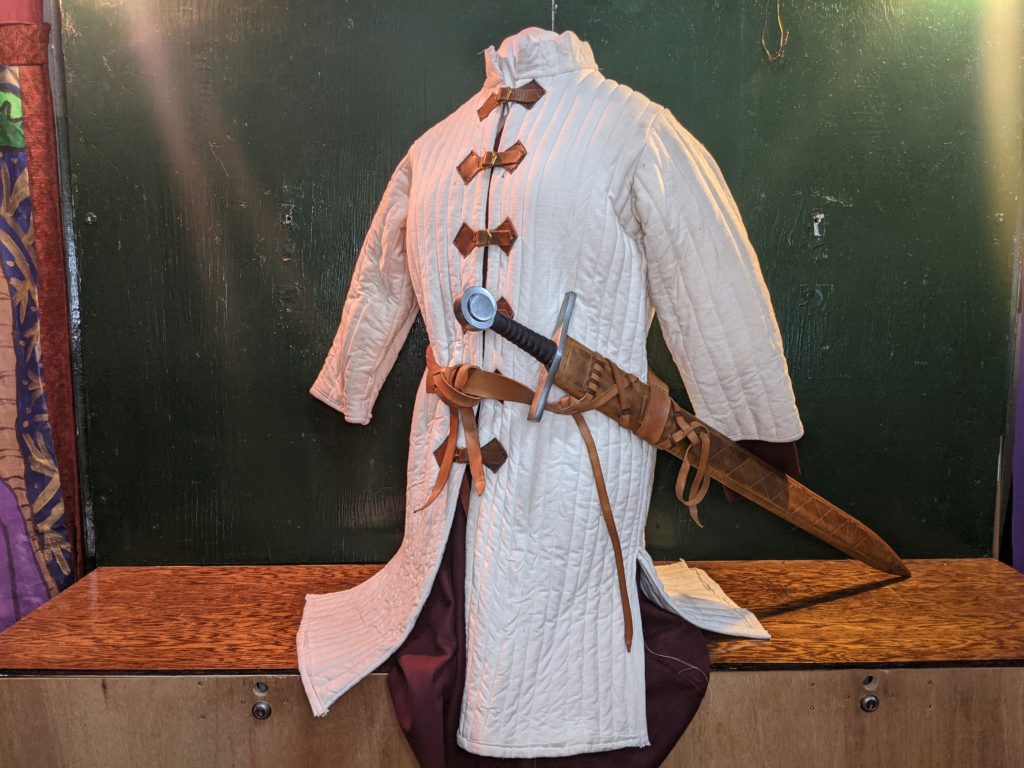
Sword belt is in two parts, each connected to the scabbard at different points causing the scabbard to tilt and lay at the proper orientation for drawing the sword. There is no metal buckle on this type of sword belt. Instead the belt is held tightly closed by weaving the ends through eyes and around the belt.
Belt with Reproduction Buckle
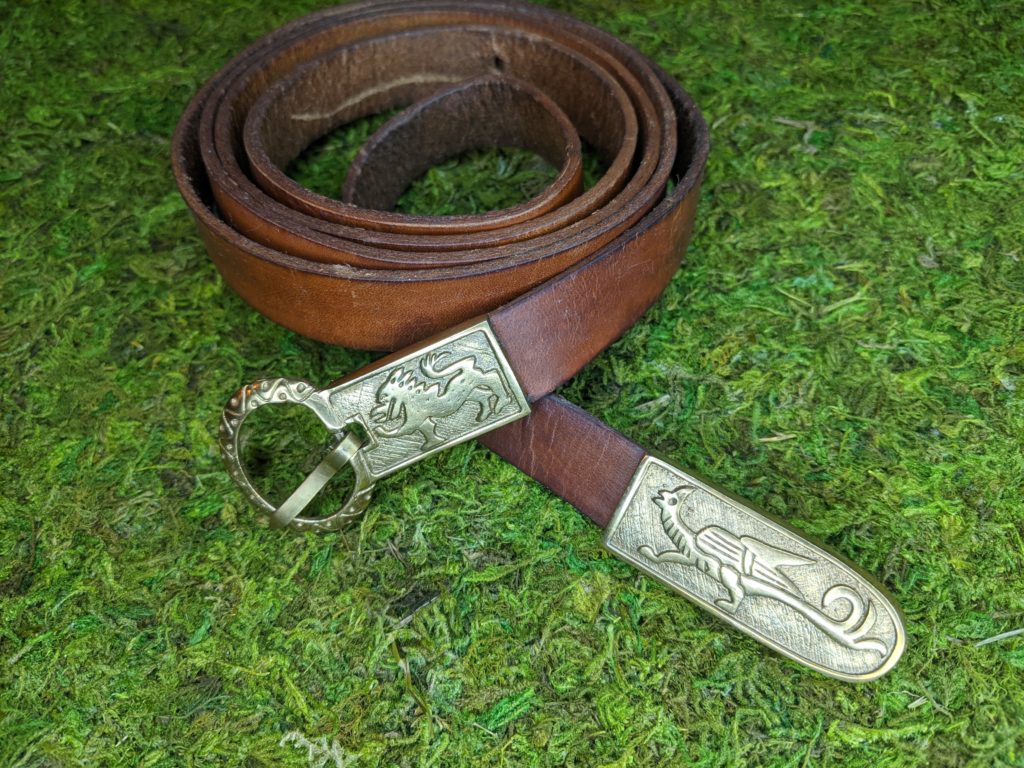
The belt around the tunic is a recreation of an actual example. The buckle is a reproduction made by vendors who cater to the reenactment community. Many extant examples of buckles, belt mounts, buttons and other metal objects are continually being discovered by metal detector enthusiasts across Europe. This allows modern craftspeople to use actual historic objects to recreate pieces for the modern reenactor.
Padded Gambeson
Padded gambesons are among the many of the kinds of quilted or cloth armor. Gambesons would have been worn on their own or as a padded under layer for a mail armor layer. The quilted linen fabric with a padded layer of wool or loose wool stuffed into the channels sewn into the cloth, form an effective armor that was far cheaper than the mail haubeck and was far more accessible to the normal foot soldier.
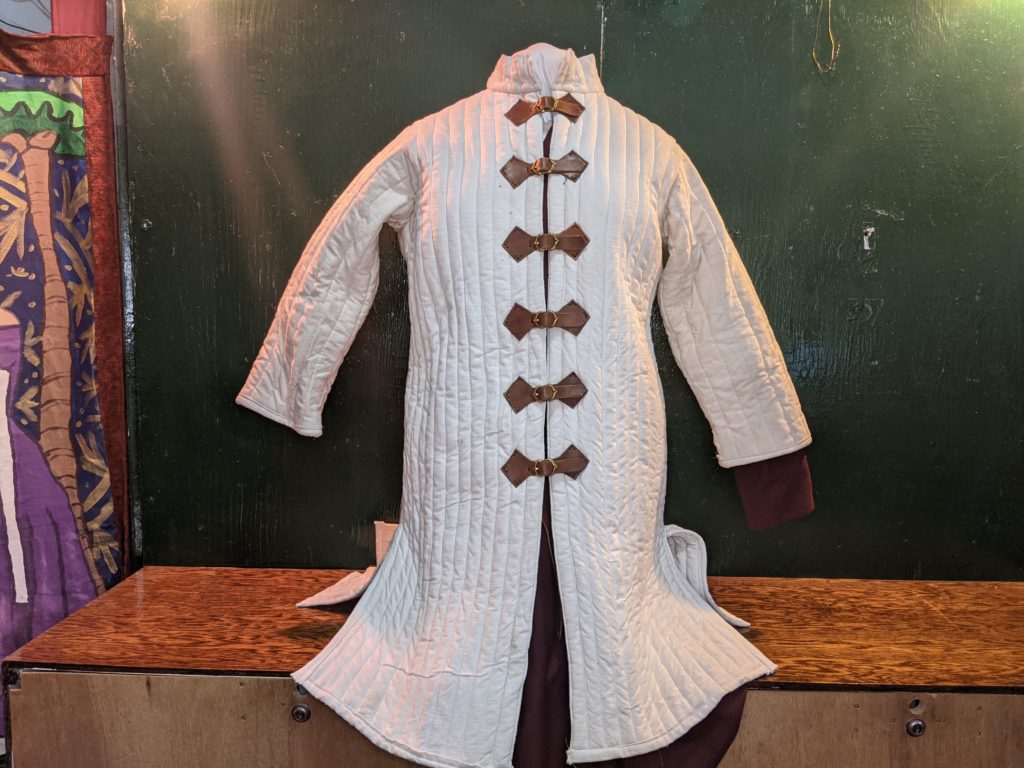
There is debate if the Norman Knights who invaded Britton would have had any padding on under their mail armor. Many experts think that the padding wasn’t used in combinations with the mail until years later. Others feel that if the fighter would have had access to it, they would have grabbed anything they could to protect themselves. Although the mail may be good at preventing cuts, it does little to protect against crushing blows.
Braies and Undershirt
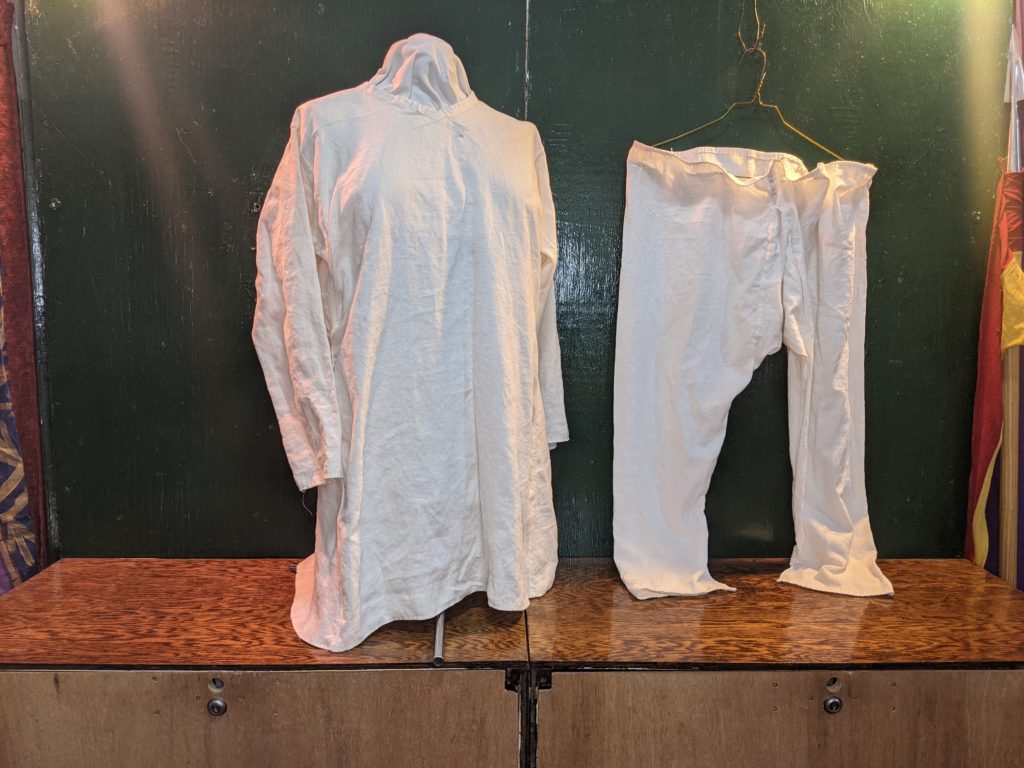
Even a knight needs his underwear. The base layer of clothing would consist of the linen underpants called braies and a linen undershirt.
Underpants take forms from long pants that go past the knees to very short briefs. The pair for our Norman Knight is a pair that hangs down past the knees and represents a type worn for hundreds of years by people of many stations in the society. They could have been made with a draw string or worn with a belt and the top of the braies rolled over the belt.
The undershirt is a base layer that helps keep the wool over layers clean beyond just being an undergarment. Very few garments from medieval times have survived intact. Many times reenactors base the design of their garments on images, carved representations or other descriptions of the garments. This undershirt was based on one surviving garment that came out of a burial in France. The original linen undershirt is on display and is commonly used as reference.
This recreation is made from modernly produced linen cloth and is hand finished. It is in a partially bleached color. In medieval times the cleaning and bleaching of white linens could be accomplished with washing in urine aged for several days to produce ammonia and then laid out to be bleached by the sun.
Shoes
The leather shoes for the Knight were important because they would have been doing a lot of walking, but not as much as the Anglo-Saxon forces they faced. Before William and out Norman Knights invaded Britton, King Harold was at another battle called Stamford Bridge where he defeated an invading Norse army. Immediately after this battle King Harold marched his forces over 200 miles south to meet the Norman forces, averaging a march of 27 miles per day.
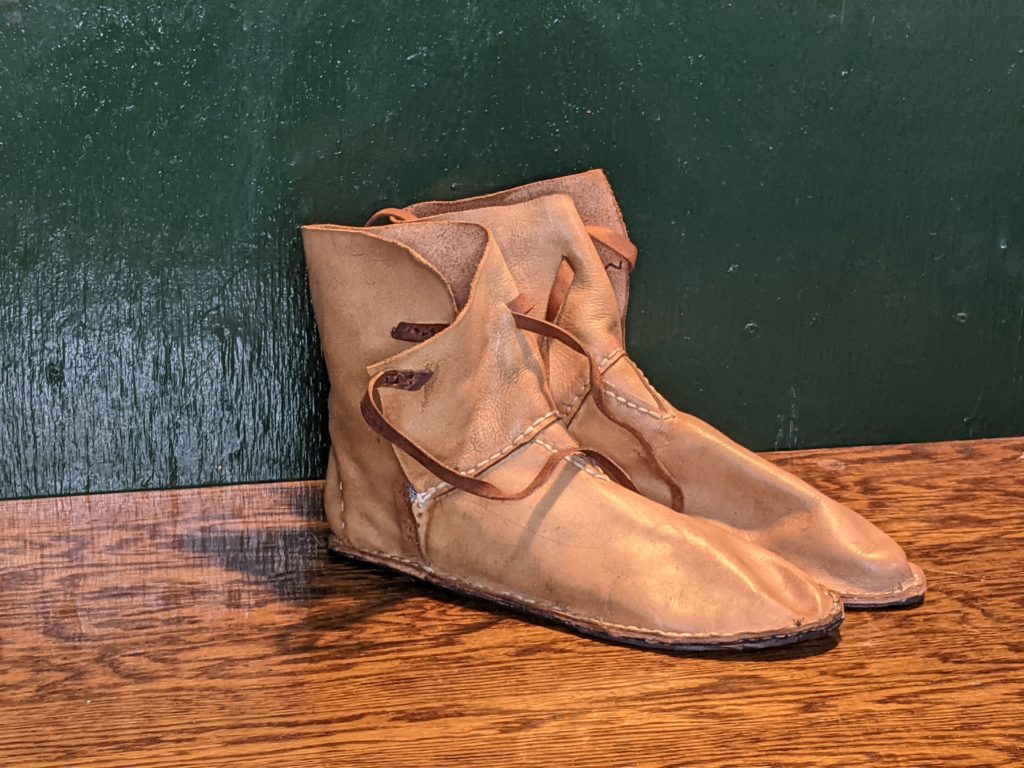
Our Norman Knight’s shoes are an attempt to recreate a formed low boot, although many of the Norman Knights at the Battle of Hastings would have had simple leather shoes with little protection for the foot. These are made by shaping wet leather around a form called a last, then stitching the shaped leather to the sole. Our shoe has some modern tread glued to the bottom to make them less slippery.
Axe
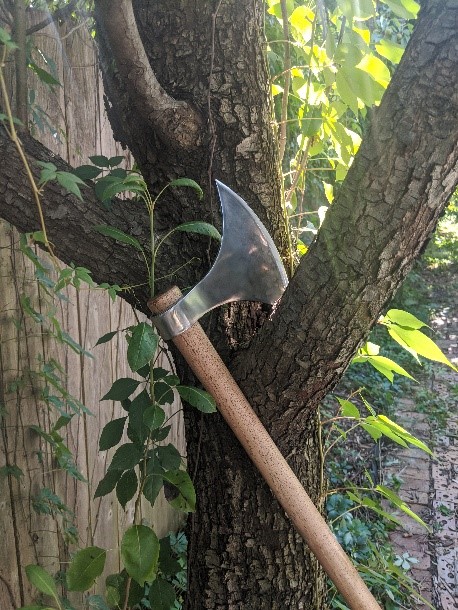
The axe was a common weapon of war throughout human history. Both the Anglo-Saxons and the Normans represented in the Bayeux Tapestry were influenced by Norse ancestors who had invaded Britton and Normandy bringing their tradition of the battle axe with them. When the Norman army invaded they relied more on their spears and swords than their axes, but the Anglo-Saxon forces of King Harold were still using many axes in the battle. The elite Anglo-Saxon force and personal guard to the king, the Housecarls, relied on their large, double handed axes, and were feared foes on the battlefield.
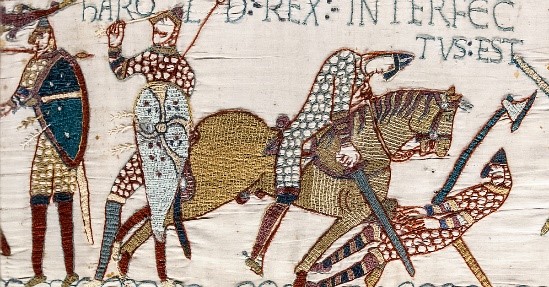
Spear
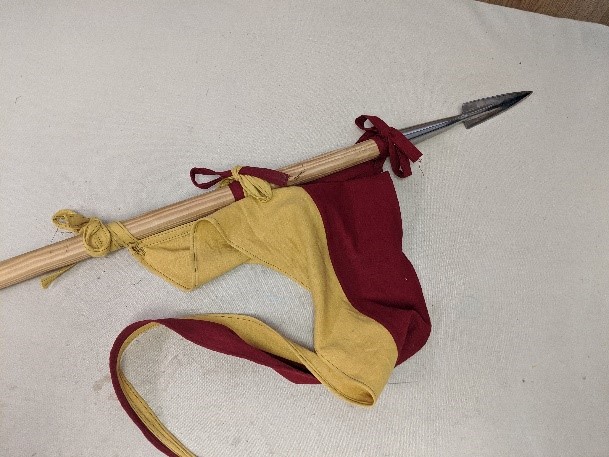
The spear was the main weapon of the mounted Norman Knight. Before wading into battle with a sword drawn they would have made multiple charges with their long spears, many depicted with a colorful flag. The sharp spearhead with the weight of the armored knight and horse behind it would inflect devastating damage to even an armored footman.
Kite Shield
Shields supplemented the armor worn by the fighter and the Bayeux Tapestry shows two different styles of shields used at the time. One, a circular shield, had been used for centuries before by many groups across Europe have a center shield boss to protect the hand of the user holding it. The Normans in the Bayeux Tapestry are shown using kite shaped shields. These are an evolution of the circular shield with the bottom edge extending down to protect more of the user.
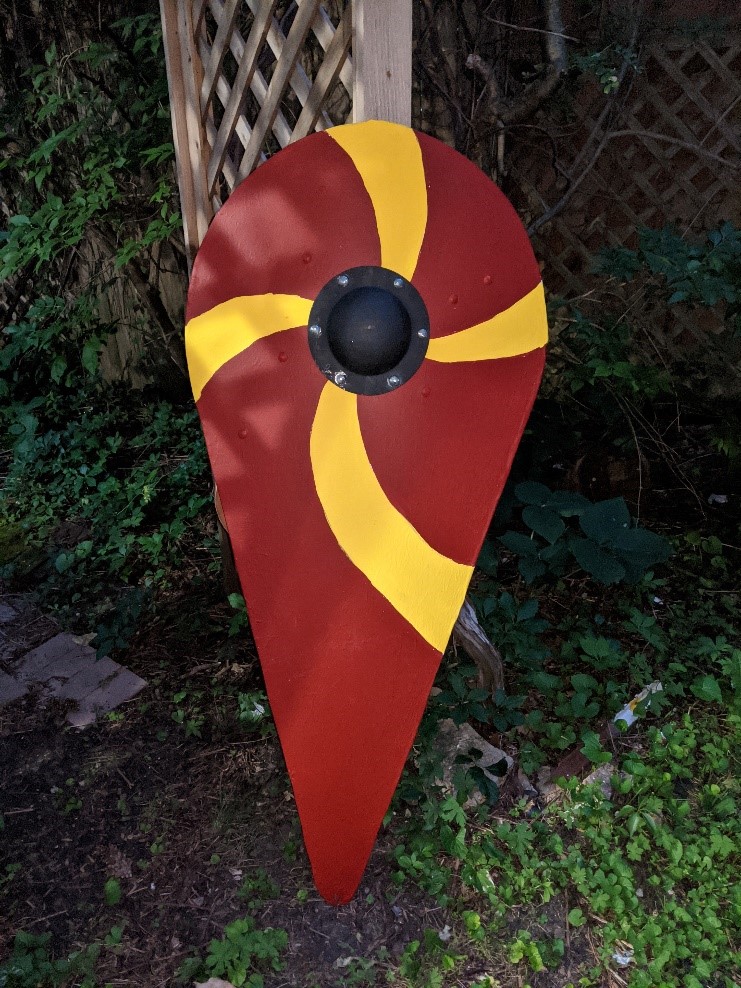
For many years historians have thought that the extension of the shield was related to its use on horseback, protecting the rider’s leg on the offhand side. Modern reenactors who use these shields in combat recreation often point out that the older round shield is far easier to use on horseback and that the kite shaped shield is more useful to the fighter on the ground. This would suggest that the Norman force that invaded Britton was prepared to fight from horseback as well as by foot and was limited in what they could bring with them as a mobile fighting force.
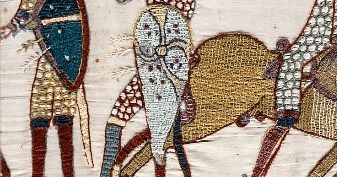
The shield for our Norman Knight is made out of layers of wood shaped unto a curve in a press. It has an iron shield boss as well as two sets of straps. One set of straps allows the user to sling the shield over a shoulder when not in battle. The other straps fit to the forearm and allow them to wield it in battle. This shield was covered in fabric before being painted. Oher shields were covered in rawhide or leather before being decorated.
The colors of our Knight
Many of the Norman invaders pictured in the Bayeux Tapestry have colorful decorations painted on their shields and helmets or flying in the flags on their spears. These allowed the fighters to identify each other on the battlefield and recognize friend and foe. Over time these traditions evolved into the heraldic displays many of us think of when we picture the middle ages. The decorations and designs as well as color combinations that allowed the identification of the fighters and nobility on the tournament field or battle field.
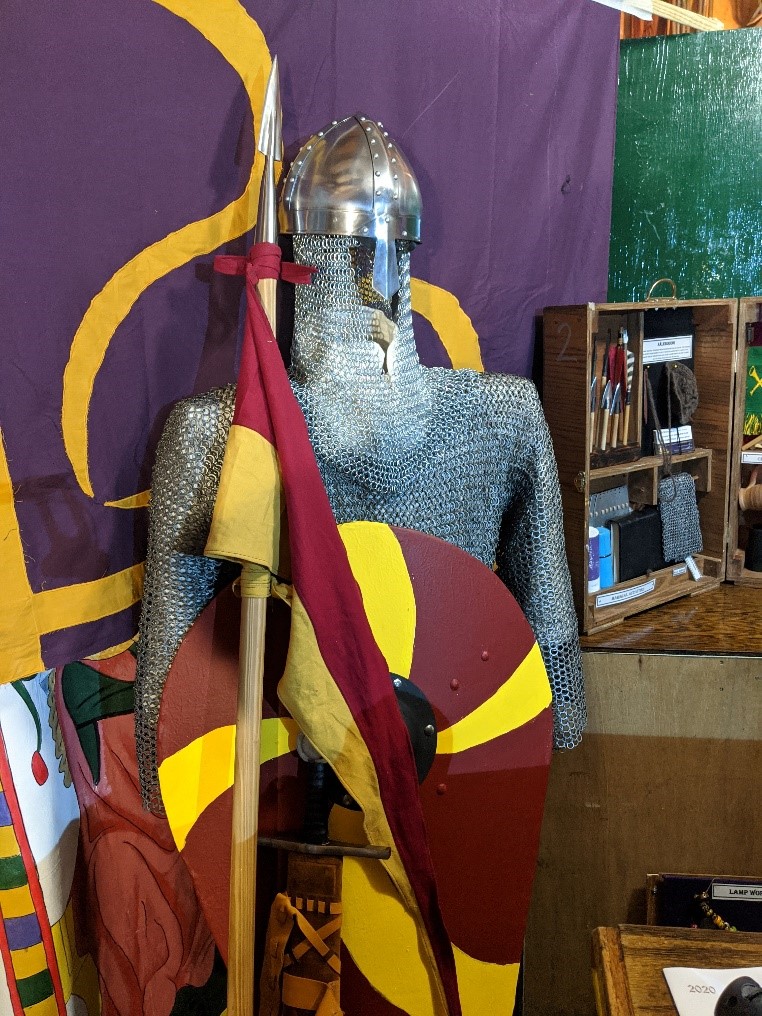
The colors of our Norman Knight are red and gold, or Gules and Or, using the French based heraldic terms. These are based on the group heraldic colors for Axed Root, the local group for Ames Iowa and surrounding communities. Its long association with Iowa State University and the several decade participation of the Medieval Recreation Club on campus, led naturally to us using these colors for our Knight.
Other interesting points about our Norman Knight;
We commonly thing about Knights being examples of virtue and upholding just causes. Many of the “Knights” who aided William the Conqueror were really just thugs, hired mercenaries who were promised access to the spoils of the battle to come. Many of them killed important Anglo-Saxon landholders and then married their widows or daughters in order to claim the lands. All the virtue stuff came later
They weren’t even called ‘Knights.” The old French of the time would have sounded a lot more like ‘kaniget’ than ‘night,’ a joke that some may spot from Monty Python and the Holy Grail.
We made a project to represent a Norman Knight, but many of the members of our local SCA kingdom, the Kingdom of Calontir, more closely identify with the defeated army of King Harold Godwinson. There are many names for awards and traditions in our local kingdom that are taken from the Anglo-Saxon traditions.
The SCA is about learning and growing. Although we try to not make mistakes, we don’t know everything and our skills and materials are not perfect. We always strive to do better, and this project of Axed Root’s Norman Knight, as with any project by a member of the SCA, represents the best we could do right now. From here we will continue to learn more and get better at our crafts. So there may be errors and imperfections, but we had a lot of fun learning as we worked on this project and we will have more fun as we learn more moving forward.
